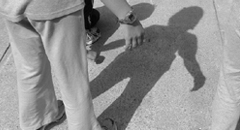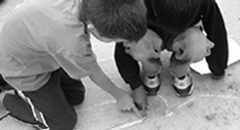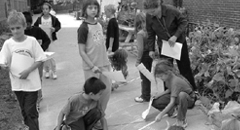
|

|

|
We have been impressed with the passionate responses and enormous enthusiasm for the chance to explore MLV ideas that seminar teachers and others express. Four areas of particular interest and insight, based on our work with the MLV Seminar, are:
Finding 1: The Formation of the Group as an Entry Point
We have noticed that many of our seminar teachers seem to gravitate to consideration of the formation of small groups as an entry point into this work. Factors that influence the formation of a learning group include the size of the group, the ages, competencies, and interests of the children, gender, friendships, and time spent together. Simply devoting time to thinking about how to form groups seems like a new experience for many teachers, perhaps because so much schoolwork is either done individually or in whole group discussions. Group work in U.S. classrooms often refers to whole-group work. But even collaborative learning models for small groups do not typically emphasize consideration of who is in each group and what individuals can bring to one another's learning. Thus, the notion that careful formation of small groups might afford a qualitatively different kind of learning is provocative to many teachers.
Finding 2: The Creation of a Collective Body of Knowledge
The idea of creating a collective body of knowledge intrigues and excites our teachers and teacher educators, yet its meaning can be elusive. This concept has prompted a great deal of discussion about the nature of the task the group is working on and led teachers to reflect on what it is the group comes together to do. Some tasks are inspiring and compelling and provide reasons for a group to come together, whereas others are far less successful. A number of teachers have identified many of their own tasks as the less successful kind, but are now trying to grapple with what is the nature of a promising task in this context.
Emerging Ideas about Tasks that Lead to Group Learning
Finding 3: Equating Learning and Work
A number of teachers noticed that their students seemed to equate "getting work done" with "learning." These teachers also realized that while they considered learning a priority, sometimes "learning" took a back seat to the work that was supposed to generate it. In the absence of alignment of many factors in the classroom, work gets equated with learning. Consider this reflection from a ninth grade student in response to a question about whether working or getting work done was the same as learning:
Most times for me it is not about learning, but completing the project. Many times I just want to complete an assignment and do not care or even think about how it may affect my learning. I guess part of the reason is [due] to my education from my past. It wasn't until I hit 8th grade people started caring about how I learned. We learned some fancy word meaning understanding how you think. It was cool to talk about, but hard to get across in an actual project.
I am asking myself, "Do I learn better in groups or by myself? What is the point of me knowing if I am learning? Shouldn't me working on something mean I am learning? Who's to say if I am learning or not? How do others learn?" These questions are now in my head after this experiment. I feel these are good questions to better understand where people are coming from.
The researcher Hermine Marshall has distinguished three kinds of orientations in classrooms: learning, work, and work-avoidance. In a learning-oriented classroom, the goal is to develop an understanding of the course topics. In these classrooms, the work is purposeful and directed at making personalized and collective sense through a building up of connections, applications, and associations. A work-oriented classroom focuses on completing the work of the course and covering the material. These classrooms are driven by completing assignments, obtaining favorable external evaluation, and moving on to the next task. In work-avoidance classrooms, students will often either try to see how much work they can avoid doing, perhaps as a result of unclear instructional goals, or there might be an unwritten compromise in which, in exchange for the teacher's not pushing too hard, students agree to remain generally complacent and compliant.
For our seminar teachers, this discovery of the distinction between doing school work and genuine learning in the group has been very important. It helped them to clarify their goals and to focus on creating genuine learning groups, not just groups in which students can get the work done.
[Home] [Site Map]